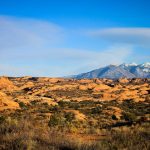- New research shows most snowmelt-fed streams are fueled by older groundwater.
- The average age of snowmelt runoff water is nearly 6 years.
- Catchment geology strongly influences water storage and runoff efficiency.
- Colorado River Basin states must rethink water models built on outdated assumptions.
Monday, May 5, 2025 — A major new study published in Nature Communications Earth & Environment challenges long-standing beliefs about snowmelt in the western United States. Contrary to the common assumption that snowmelt directly and quickly flows into rivers and streams, researchers found that the majority of this runoff actually originates from groundwater that has been underground for years.
challenges long-standing beliefs about snowmelt in the western United States. Contrary to the common assumption that snowmelt directly and quickly flows into rivers and streams, researchers found that the majority of this runoff actually originates from groundwater that has been underground for years.
Using tritium—a hydrogen isotope left over from nuclear testing in the 1950s—scientists dated water samples from 42 mountain watersheds. They discovered that the average snowmelt runoff water was 5.7 years old, while the base groundwater feeding it was typically 10.4 years old. In simple terms, over half of what flows down streams in spring comes from rain and snow that fell many years ago.
Implications for the Western States.
This finding is particularly important for the seven states that rely heavily on water from the Colorado River Basin. These states base much of their water management and forecasting on models that assume a “use-it-or-lose-it” snowmelt cycle each year. The study shows that’s no longer valid.
“Snowmelt runoff is the result of multiple prior years of climate mediated by groundwater storage,” the authors wrote . That means today’s water was stored underground during wetter years, which has direct implications for how much water these states can count on in dry years.
. That means today’s water was stored underground during wetter years, which has direct implications for how much water these states can count on in dry years.
Geology Matters.
Not all watersheds behave the same. Watersheds with low-permeability rock (such as shale and hard rock) were found to have younger water with less underground storage and quicker runoff. In contrast, those with high-permeability sandstone and clastic formations stored far more water underground and released it more slowly—sometimes over a decade.
This geological difference affects not just how old the water is, but also how efficiently precipitation becomes streamflow. In areas with more underground storage, a greater share of the water is lost to evaporation or plant use. That means less reaches rivers.
The Colorado River Forecasting Problem.
Forecasting tools that assume shallow soils and quick runoff now appear inadequate. Older models built on seasonal snowpack data often fail to predict the actual amount of runoff. In areas like the Upper Colorado River Basin, this has led to increasing uncertainty about future water supplies.
The study suggests a “fundamental change” is needed in water modeling. Instead of assuming that all water moves through the system annually, new models should include multi-year groundwater storage and release.
Policy and Management Ramifications.
This research comes at a time when the Colorado River Basin is facing intense negotiations over future water-sharing rules. Population growth, prolonged drought, and changing climate patterns are making old agreements harder to uphold.
The authors recommend that water managers begin using tritium testing more regularly, especially in winter and spring, to track changes in underground water storage. Doing so could dramatically improve forecasts and planning.
more regularly, especially in winter and spring, to track changes in underground water storage. Doing so could dramatically improve forecasts and planning.
Additionally, knowing which areas have older water and larger storage could help in planning for droughts or wildfires. For example, forests in areas with low-permeability rock may be more vulnerable to climate stress due to smaller water reserves.
A Call for Modernization.
The study concludes that the western U.S. needs updated tools to manage water supplies amid rapid climate change. “Streamflow generation, and response to climate or disturbance, in mountain catchments is better represented by a subsurface with greater capacity for water storage,” the researchers stated.
concludes that the western U.S. needs updated tools to manage water supplies amid rapid climate change. “Streamflow generation, and response to climate or disturbance, in mountain catchments is better represented by a subsurface with greater capacity for water storage,” the researchers stated.
This means ditching one-size-fits-all assumptions and adopting catchment-specific planning strategies. For the seven Colorado River Basin states, this knowledge could become essential in adapting to future water realities.
Citation.
Brooks, P.D., Solomon, D.K., Kampf, S. et al. Groundwater dominates snowmelt runoff and controls streamflow efficiency in the western United States. Commun Earth Environ 6, 341 (2025). https://doi.org/10.1038/s43247-025-02303-3




Leave a Reply